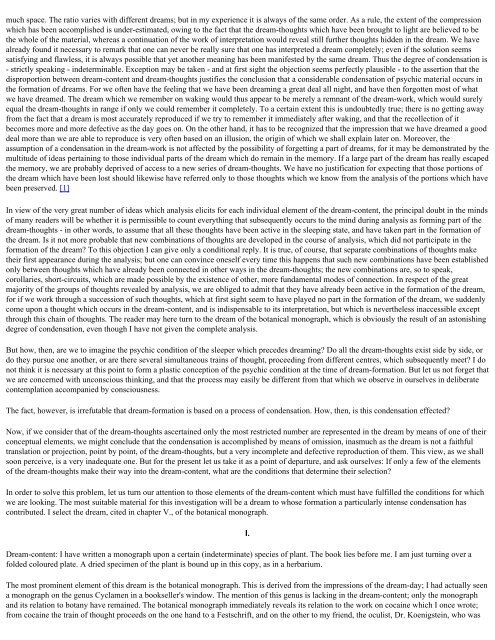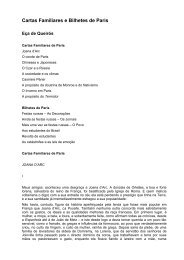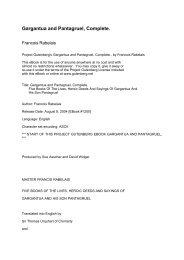The Interpretation of Dreams Sigmund Freud (1900)
The Interpretation of Dreams Sigmund Freud (1900)
The Interpretation of Dreams Sigmund Freud (1900)
Create successful ePaper yourself
Turn your PDF publications into a flip-book with our unique Google optimized e-Paper software.
much space. <strong>The</strong> ratio varies with different dreams; but in my experience it is always <strong>of</strong> the same order. As a rule, the extent <strong>of</strong> the compression<br />
which has been accomplished is under-estimated, owing to the fact that the dream-thoughts which have been brought to light are believed to be<br />
the whole <strong>of</strong> the material, whereas a continuation <strong>of</strong> the work <strong>of</strong> interpretation would reveal still further thoughts hidden in the dream. We have<br />
already found it necessary to remark that one can never be really sure that one has interpreted a dream completely; even if the solution seems<br />
satisfying and flawless, it is always possible that yet another meaning has been manifested by the same dream. Thus the degree <strong>of</strong> condensation is<br />
- strictly speaking - indeterminable. Exception may be taken - and at first sight the objection seems perfectly plausible - to the assertion that the<br />
disproportion between dream-content and dream-thoughts justifies the conclusion that a considerable condensation <strong>of</strong> psychic material occurs in<br />
the formation <strong>of</strong> dreams. For we <strong>of</strong>ten have the feeling that we have been dreaming a great deal all night, and have then forgotten most <strong>of</strong> what<br />
we have dreamed. <strong>The</strong> dream which we remember on waking would thus appear to be merely a remnant <strong>of</strong> the dream-work, which would surely<br />
equal the dream-thoughts in range if only we could remember it completely. To a certain extent this is undoubtedly true; there is no getting away<br />
from the fact that a dream is most accurately reproduced if we try to remember it immediately after waking, and that the recollection <strong>of</strong> it<br />
becomes more and more defective as the day goes on. On the other hand, it has to be recognized that the impression that we have dreamed a good<br />
deal more than we are able to reproduce is very <strong>of</strong>ten based on an illusion, the origin <strong>of</strong> which we shall explain later on. Moreover, the<br />
assumption <strong>of</strong> a condensation in the dream-work is not affected by the possibility <strong>of</strong> forgetting a part <strong>of</strong> dreams, for it may be demonstrated by the<br />
multitude <strong>of</strong> ideas pertaining to those individual parts <strong>of</strong> the dream which do remain in the memory. If a large part <strong>of</strong> the dream has really escaped<br />
the memory, we are probably deprived <strong>of</strong> access to a new series <strong>of</strong> dream-thoughts. We have no justification for expecting that those portions <strong>of</strong><br />
the dream which have been lost should likewise have referred only to those thoughts which we know from the analysis <strong>of</strong> the portions which have<br />
been preserved. [1]<br />
In view <strong>of</strong> the very great number <strong>of</strong> ideas which analysis elicits for each individual element <strong>of</strong> the dream-content, the principal doubt in the minds<br />
<strong>of</strong> many readers will be whether it is permissible to count everything that subsequently occurs to the mind during analysis as forming part <strong>of</strong> the<br />
dream-thoughts - in other words, to assume that all these thoughts have been active in the sleeping state, and have taken part in the formation <strong>of</strong><br />
the dream. Is it not more probable that new combinations <strong>of</strong> thoughts are developed in the course <strong>of</strong> analysis, which did not participate in the<br />
formation <strong>of</strong> the dream? To this objection I can give only a conditional reply. It is true, <strong>of</strong> course, that separate combinations <strong>of</strong> thoughts make<br />
their first appearance during the analysis; but one can convince oneself every time this happens that such new combinations have been established<br />
only between thoughts which have already been connected in other ways in the dream-thoughts; the new combinations are, so to speak,<br />
corollaries, short-circuits, which are made possible by the existence <strong>of</strong> other, more fundamental modes <strong>of</strong> connection. In respect <strong>of</strong> the great<br />
majority <strong>of</strong> the groups <strong>of</strong> thoughts revealed by analysis, we are obliged to admit that they have already been active in the formation <strong>of</strong> the dream,<br />
for if we work through a succession <strong>of</strong> such thoughts, which at first sight seem to have played no part in the formation <strong>of</strong> the dream, we suddenly<br />
come upon a thought which occurs in the dream-content, and is indispensable to its interpretation, but which is nevertheless inaccessible except<br />
through this chain <strong>of</strong> thoughts. <strong>The</strong> reader may here turn to the dream <strong>of</strong> the botanical monograph, which is obviously the result <strong>of</strong> an astonishing<br />
degree <strong>of</strong> condensation, even though I have not given the complete analysis.<br />
But how, then, are we to imagine the psychic condition <strong>of</strong> the sleeper which precedes dreaming? Do all the dream-thoughts exist side by side, or<br />
do they pursue one another, or are there several simultaneous trains <strong>of</strong> thought, proceeding from different centres, which subsequently meet? I do<br />
not think it is necessary at this point to form a plastic conception <strong>of</strong> the psychic condition at the time <strong>of</strong> dream-formation. But let us not forget that<br />
we are concerned with unconscious thinking, and that the process may easily be different from that which we observe in ourselves in deliberate<br />
contemplation accompanied by consciousness.<br />
<strong>The</strong> fact, however, is irrefutable that dream-formation is based on a process <strong>of</strong> condensation. How, then, is this condensation effected?<br />
Now, if we consider that <strong>of</strong> the dream-thoughts ascertained only the most restricted number are represented in the dream by means <strong>of</strong> one <strong>of</strong> their<br />
conceptual elements, we might conclude that the condensation is accomplished by means <strong>of</strong> omission, inasmuch as the dream is not a faithful<br />
translation or projection, point by point, <strong>of</strong> the dream-thoughts, but a very incomplete and defective reproduction <strong>of</strong> them. This view, as we shall<br />
soon perceive, is a very inadequate one. But for the present let us take it as a point <strong>of</strong> departure, and ask ourselves: If only a few <strong>of</strong> the elements<br />
<strong>of</strong> the dream-thoughts make their way into the dream-content, what are the conditions that determine their selection?<br />
In order to solve this problem, let us turn our attention to those elements <strong>of</strong> the dream-content which must have fulfilled the conditions for which<br />
we are looking. <strong>The</strong> most suitable material for this investigation will be a dream to whose formation a particularly intense condensation has<br />
contributed. I select the dream, cited in chapter V., <strong>of</strong> the botanical monograph.<br />
Dream-content: I have written a monograph upon a certain (indeterminate) species <strong>of</strong> plant. <strong>The</strong> book lies before me. I am just turning over a<br />
folded coloured plate. A dried specimen <strong>of</strong> the plant is bound up in this copy, as in a herbarium.<br />
I.<br />
<strong>The</strong> most prominent element <strong>of</strong> this dream is the botanical monograph. This is derived from the impressions <strong>of</strong> the dream-day; I had actually seen<br />
a monograph on the genus Cyclamen in a bookseller's window. <strong>The</strong> mention <strong>of</strong> this genus is lacking in the dream-content; only the monograph<br />
and its relation to botany have remained. <strong>The</strong> botanical monograph immediately reveals its relation to the work on cocaine which I once wrote;<br />
from cocaine the train <strong>of</strong> thought proceeds on the one hand to a Festschrift, and on the other to my friend, the oculist, Dr. Koenigstein, who was









